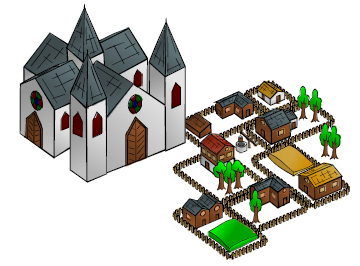The first days of the new year are a good moment to look back at the past year and see what have been the most read articles of the site, this is also a good opportunity for you to read (or re-read) them. And, a bit late, but i wish you all a Happy New Year.
10 – How to run commands in the background
Suppose you have a long-running task (for example, compiling a large program) that you need to run, but you also want to get some other work done. Linux lets you start a task in the background and keep on doing other things from the command prompt.
We will see in this article how to send commands in the background, then return them to the foreground, and make sure that also closing the current shell or terminal the process doesn’t remains tied to the session but continue to work.
An alternative to these command is using screen, as read in a former article, but now let’s seethe command bg and the spacial character &
9 – Use SSH for more secure browsing in public networks
In the time of free wifi and free internet connections in every hotel, bar or cafe you should be sure your connections are secure. In some cases you can’t trust the connection but you need to go online and read some mails or share some documents. In this case some basic tools like SSH and Firefox can help you to build a secure connection to a known computer in the internet you can trust (for example your own root server).
8 – Do more with less
less it’s a fundamental command if you work on the Linux terminal.
Doing a “man less” you can see:
NAME less - opposite of more
I love Gnu/Linux man pages, in this case it refer to more another command that do similar things (but less).
The Linux command less is similar to cat, but with less you can scroll the file instead of showing the file at once. With less command you can scroll up in the file as well as down, where with the Linux command more you can only scroll down the file.
7 – 3 Open source monitoring programs
 If in your work you are responsible for just one server, you will surely wonder: What is the best way to get the situation under control?
If in your work you are responsible for just one server, you will surely wonder: What is the best way to get the situation under control?
In the world there are good open source software that allow you to monitor the status of servers, services and programs.
In this article we’ll see an overview some of the software in this category, and in particular some related to Nagios
6 – Understanding Nmap Commands: In depth Tutorial with examples
As we all know, Nmap (Network Mapper) is a stealth port scanner widely used by network security experts (including forensics & Pen-testing Experts). In this article we’ll see the different types of Nmap Scans, its techniques, understanding the purpose and goals of each scan , its advantages or disadvantages over other scanning tools, which could be better at evading firewalls & IDS (To a certain extent) and much more. In this first part, I have made my best to explain the basic scanning techniques, Host discovery options, port scanning options, techniques used in detecting Operating system & services running on the system.
i also give Nmap as already installed on your system.
5 – 3 Command line tool to test bandwidth between 2 servers
 One element that is often not know, or that should be measured after a problem statement or after a change in the infrastructure is the network . But how do you accurately measure the speed between two servers?
One element that is often not know, or that should be measured after a problem statement or after a change in the infrastructure is the network . But how do you accurately measure the speed between two servers?
Someone use ftp, scp or other file transfer protocols, these can give some indication, but probably you’ll measure the limit of your disks or CPU.
In this article I will show you 3 way to measure the bandwidth from the command line, without using the disks.
4 – 6 Open Source CMDB
A fundamental item for those who work according to ITIL best practices is definitely CMDB.
A configuration management database (CMDB) is a repository of information related to all the components of an information system. Although repositories similar to CMDBs have been used by IT departments for many years, the term CMDB stems from ITIL. In the ITIL context, a CMDB represents the authorized configuration of the significant components of the IT environment. A CMDB helps an organization understand the relationships between these components and track their configuration.
There are many commercial products that offer solutions that should cover every aspect of a company, but than you discover that these software are huge, difficult to manage and impossible to use and customize without the help of a consultant.
That is why today I will propose some open source software for designing your CMDB.
3 – Cheat Sheet collection
 For Wikipedia: A cheat sheet or crib sheet is a concise set of notes used for quick reference. “Cheat sheet” may also be rendered “cheatsheet”.
For Wikipedia: A cheat sheet or crib sheet is a concise set of notes used for quick reference. “Cheat sheet” may also be rendered “cheatsheet”.
People working in informatics in general and on unix terminals in particular know that is not so easy remember every single command and so it’s usual to have “Cheat Sheet”, a collection of the most useful commands in a single A4 page for a particular program or environment.
And this is my small collection.
2 – 12 Open Source Books
Open source is very dedicated to sharing information, comparing and learning, then in this article i will recommend some readings of open books that you can download, read and if you want print freely.
The Cathedral and the Bazaar
Available in many languages; This is a great essay on the difference between the open source model of software development, and the closed source model employed by commercial software vendors. It is a great read that is as true as when it was written, to the present day today
1 –10 Easter Eggs in Linux
 Happy easter to all, what’s better than celebrate this holiday taking a look at what have hidden the programmers in our software ?
Happy easter to all, what’s better than celebrate this holiday taking a look at what have hidden the programmers in our software ?
A virtual Easter egg is an intentional hidden message, in-joke or feature in a work such as a computer program, web page, video game, movie, book or crossword. The term was coined—according to Warren Robinett—by Atari after they were pointed to the secret message left by Robinett in the game Adventure.
Popular Posts:
- None Found



“riga di comando”, non “linea di comando”, perché il comando sta scritto su una riga, a volte su più righe, ma mai su una linea… (linea retta o linea curva?) 😉
fonte: http://tp.linux.it/glossario.html
A questo non avevo mai pensato, ed in effetti mi rendo conto di aver sempre usato linea e riga alternativamente, e senza accorgermene.
Proverò a correggermi, grazie 😉